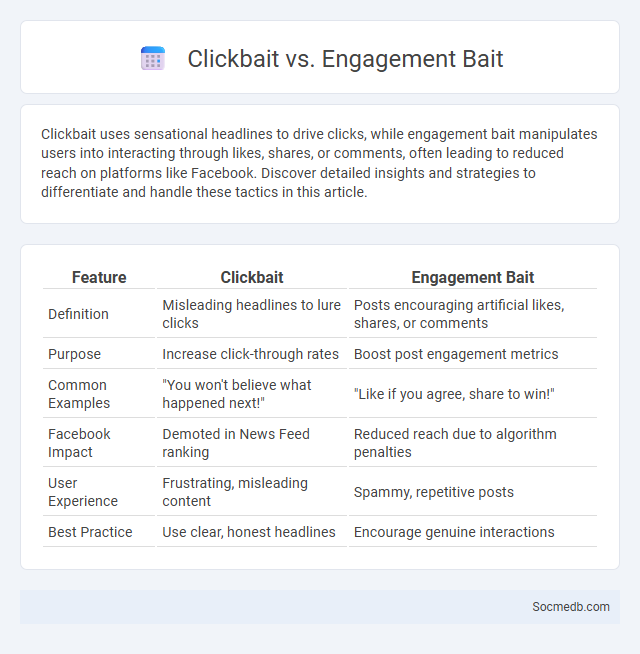
Photo illustration: Clickbait vs engagement bait
Clickbait uses sensational headlines to drive clicks, while engagement bait manipulates users into interacting through likes, shares, or comments, often leading to reduced reach on platforms like Facebook. Discover detailed insights and strategies to differentiate and handle these tactics in this article.
Table of Comparison
| Feature | Clickbait | Engagement Bait |
|---|---|---|
| Definition | Misleading headlines to lure clicks | Posts encouraging artificial likes, shares, or comments |
| Purpose | Increase click-through rates | Boost post engagement metrics |
| Common Examples | "You won't believe what happened next!" | "Like if you agree, share to win!" |
| Facebook Impact | Demoted in News Feed ranking | Reduced reach due to algorithm penalties |
| User Experience | Frustrating, misleading content | Spammy, repetitive posts |
| Best Practice | Use clear, honest headlines | Encourage genuine interactions |
Understanding Clickbait: Definition and Purpose
Clickbait refers to content crafted with sensationalized headlines or thumbnails designed to attract clicks and drive web traffic. Its primary purpose is to boost engagement metrics such as page views, ad revenue, and social shares, often at the expense of delivering substantive or accurate information. Understanding the psychological triggers behind clickbait, including curiosity gaps and emotional appeal, helps in discerning credible content from manipulative digital tactics.
What is Engagement Bait?
Engagement bait refers to social media posts designed to manipulate users into interacting through likes, shares, comments, or reactions to artificially boost visibility. Common tactics include asking users to "like if you agree," "tag a friend," or participate in polls purely to increase engagement metrics. Platforms like Facebook and Instagram actively demote such content to maintain authentic user experiences and reduce spammy behavior.
Key Differences: Clickbait vs Engagement Bait
Clickbait headlines use sensationalized or misleading language to lure users into clicking, often prioritizing short-term traffic over content quality, while engagement bait encourages users to interact through prompts like "tag a friend" or "comment below," aiming to boost algorithmic visibility. Clickbait typically results in high bounce rates and low user satisfaction due to unmet expectations, whereas engagement bait fosters active participation but can be penalized by social media platforms for manipulative tactics. Understanding these distinctions helps marketers optimize content strategies to balance audience growth with platform compliance.
Common Characteristics of Clickbait Content
Clickbait content on social media often features sensational headlines designed to provoke strong emotions and curiosity, enticing users to click without revealing full information. Such posts use exaggerated claims, misleading thumbnails, and vague promises to maximize engagement and shares. Recognizing these common characteristics helps you avoid deceptive content and make informed decisions online.
Types of Engagement Bait on Social Media
Engagement bait on social media includes tactics like "Like Bait," where users are urged to like a post to show support, "Comment Bait" which encourages comments to boost visibility, "Share Bait" promoting shares to expand reach, and "Reaction Bait" designed to elicit specific emoji reactions. These types of bait exploit platform algorithms by artificially inflating user interactions, often leading to lower quality content surfacing in feeds. Platforms like Facebook actively penalize pages that repeatedly use engagement bait to maintain authentic user experiences.
Why Clickbait is Effective (and Risky)
Clickbait leverages curiosity gaps and emotional triggers to drive high click-through rates on social media platforms, boosting engagement metrics like shares and comments. Its effectiveness stems from exploiting users' natural desire for quick, sensational information, which algorithms prioritize to increase content visibility. However, clickbait risks damaging brand reputation and reducing long-term audience trust due to misleading or exaggerated headlines leading to disappointment and decreased user loyalty.
How Engagement Bait Manipulates Algorithms
Engagement bait exploits social media algorithms by prompting users to react, comment, or share content through misleading calls to action, falsely inflating interaction metrics. Platforms like Facebook and Instagram have updated their algorithms to detect and downrank posts employing tactics such as vote baiting, share baiting, and tag baiting, reducing the reach of such manipulative content. This manipulation disrupts authentic user experience and undermines algorithm integrity by prioritizing quantity of engagement over content quality.
The Impact on Audience Trust and Brand Reputation
Social media profoundly influences audience trust and brand reputation by shaping public perception through real-time engagement and transparent communication. Consistent, authentic interactions on platforms like Instagram, Twitter, and LinkedIn enhance Your brand's credibility and foster loyal communities. Negative feedback or misinformation spreading rapidly on social channels can damage reputation, making proactive reputation management essential for sustaining audience trust.
Ethical Alternatives to Clickbait and Engagement Bait
Ethical alternatives to clickbait and engagement bait emphasize creating authentic, valuable content that respects your audience's intelligence and trust. You can boost engagement by crafting headlines and posts that accurately represent the content, fostering genuine interaction and meaningful conversations. Prioritizing transparency and relevance ensures your social media presence builds lasting connections rather than fleeting clicks.
Best Practices for Authentic Audience Engagement
Engage your audience on social media by creating genuine, value-driven content that resonates with their interests and needs. Consistently respond to comments and messages to build trust and foster meaningful interactions. Use analytics to refine your approach, ensuring your strategies align with audience preferences and behaviors for sustained engagement.
 socmedb.com
socmedb.com